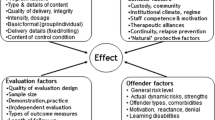Abstract
Objectives
Report insights from the career of the noted evaluation researcher, Ted Palmer, on emerging issues in correctional research and correctional treatment.
Method
Not applicable.
Results
Ted Palmer discussed the favorable and productive research climate at the California Youth Authority and the California Department of Corrections during the 1960s and 1970s. Research departments in both agencies had strong backing from the Governor and the state legislature. The research divisions were staffed by renowned social scientists who were able to work independently and free from political influence mostly because the state was growing rapidly and needed evidence to support the increasing number of state investments. Robert Martinson’s 1974 study asserting that “nothing worked” in correctional treatment effectively dismantled treatment programming in California. Ted Palmer’s response to Martinson involved an independent review of the same studies. The Palmer review reached the conclusion that programs meeting certain characteristics did in fact reduce recidivism. Ted experienced a number of attacks from Martinson and explained that it was essential to just keep to the science of the work, avoiding personal attacks. Palmer later expanded this inquiry into a book. Ted Palmer gave special credit to recent researchers, Canadian scholars especially, for meta-analyses and other studies that effectively showed that some types of correctional rehabilitation programs effectively reduced recidivism. Ted recounted that he believed the most valuable findings of the classic experimental study, the Community Treatment Project, concerned the guidance for differential approaches and relationship styles for youth. He noted the importance of treating three conditions: internal conflicts, deficits in social skills, and external pressures. Ted observed that contemporary treatment approaches tend to ignore internal, psychological problems and conflicts. He offered several recommendations regarding future research priorities. The field needs larger studies with longer follow-up periods that allow for a more thorough examination of optimal program conditions.
Conclusion
Not applicable.
Similar content being viewed by others
References
Adams, S. (1976). Evaluation: A way out of rhetoric. In R. Martinson, T. Palmer, & S. Adams (Eds.), Rehabilitation, recidivism, and research (pp. 75–91). Hackensack: National Council on Crime and Delinquency.
Andrews, D., & Bonta, J. (2010). The psychology of criminal conduct (5th ed.). Cincinnati: Anderson.
Andrews, D., Zinger, I., Hoge, R., Bonta, J., Gendreau, P., & Cullen, F. (1990). Does correctional treatment work? A psychologically informed meta-analysis. Criminology, 28, 369–404.
Bailey, W. (1966). Correctional outcome: an evaluation of 100 reports. Journal of Criminal Law, Criminology and Police Science, 57, 153–160.
Binder, A., & Geis, G. (1984). Ad Populum argumentation in criminology: juvenile diversion as rhetoric. Crime and Delinquency, 30, 624–647.
Cressey, D. (1958). The nature and effectiveness of correctional techniques. Law and Contemporary Problems, 23, 754–771.
Cullen, F. (2005). The twelve people who saved rehabilitation: how the science of criminology made a difference: the American Society of Criminology 2004 presidential address. Criminology, 43, 1–42.
Cullen, F. T., & Gilbert, K. E. (1982). Reaffirming rehabilitation. Cincinnati: Anderson
Gendreau, P. (1996). The principles of effective intervention with offenders. In A. Harland (Ed.), Choosing correctional options that work: Defining the demand and evaluating the supply (pp. 117–130). Thousand Oaks: Sage.
Gold, M. (1974). A time for scepticism. Crime and Delinquency, 20, 20–24.
Gottfredson, M. (1979). Treatment destruction techniques. Journal of Research in Crime and Delinquency, 16, 39–54.
Kirby, B. (1954). Measuring effects of treatment of criminals and delinquents. Sociology and Social Research, 38, 368–375.
Lipsey, M. (1992). Juvenile delinquency treatment: A meta-analytic inquiry into the variability of effects. In T. Cook, H. Cooper, D. Cordray, H. Hartman, L. Hedges, R. Light, T. Louis, & F. Mosteller (Eds.), Meta analysis for explanation (pp. 83–127). New York: Russell Sage.
Lipton, D., Martinson, R., & Wilks, J. (1975). The effectiveness of correctional treatment: A survey of treatment evaluation studies. New York: Praeger.
Martinson, R. (1974). What works? Questions and answers about prison reform. The Public Interest, 35, 22–54.
Martinson, R. (1976). California research at the crossroads. Crime and Delinquency, 13, 180–191.
Palmer, T. (1974). The youth authority’s community treatment project. Federal Probation, 38, 3–14.
Palmer, T. (1975). Martinson revisited. Journal of Research in Crime and Delinquency, 12, 133–152.
Palmer, T. (1978). Correctional intervention and research. Lexington: D.C. Heath.
Palmer, T. (1992). The re-emergence of correctional intervention. Newbury Park: Sage.
Palmer, T. (1994). A profile of correctional effectiveness and new directions for research. Albany: SUNY.
Palmer, T. (2002). Individualized intervention with young multiple offenders: The California Community Treatment Project. Hampton: Garland.
Sechrest, L., White S. O., & Brown, E. D. (Eds). (1979). The rehabilitation of criminal offenders: problems and prospects. Panel on Research on Rehabilitative Techniques, Committee on Research on Law Enforcement and Criminal Justice. Washington, D.C.: National Academy of Sciences.
Sullivan, C., Grant, M., & Grant, D. (1957). The development of interpersonal maturity: an application to delinquency. Psychiatry, 20, 373–385.
von Hirsch, A. (1976). Doing Justice: The Choice of Punishments. New York: Hill & Wang.
Wootton, B. (1959). Social science and social pathology. London: George Allen and Unwin.
Author information
Authors and Affiliations
Corresponding author
Rights and permissions
About this article
Cite this article
Palmer, T., Van Voorhis, P., Taxman, F.S. et al. Insights from Ted Palmer: experimental criminology in a different era. J Exp Criminol 8, 103–115 (2012). https://doi.org/10.1007/s11292-012-9145-0
Published:
Issue Date:
DOI: https://doi.org/10.1007/s11292-012-9145-0




